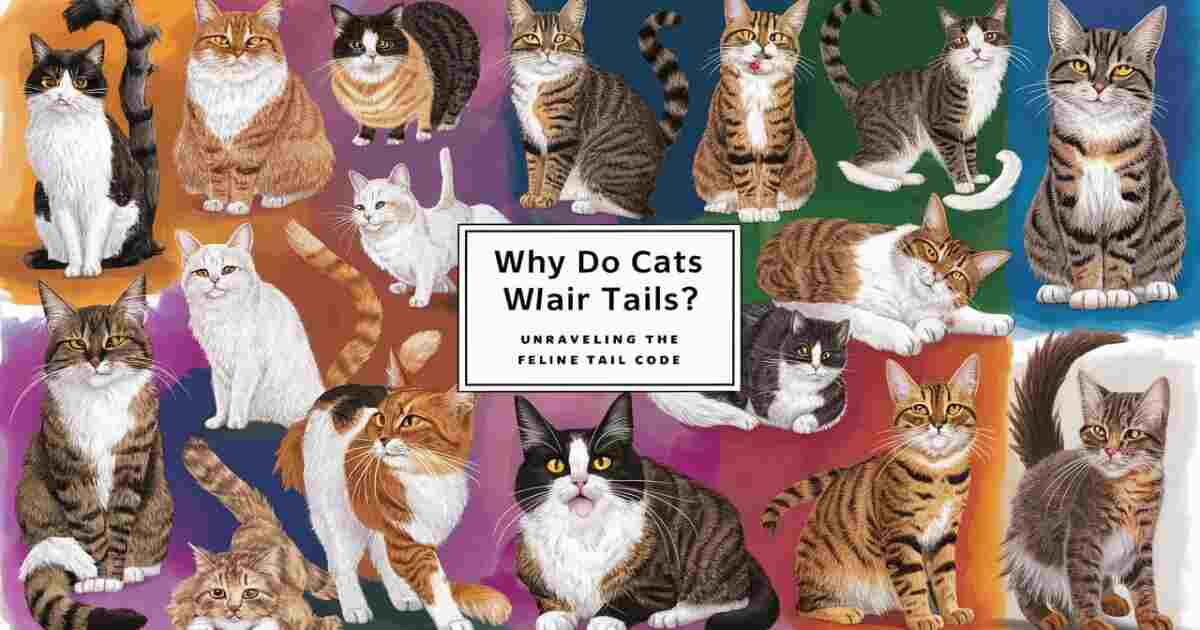Why Do Cats Wag Their Tails? Unraveling the Feline Tail Code
A cat’s tail is more than just a pretty feature; it helps them communicate. Unlike dogs, where a wagging tail usually means they’re happy, a cat’s tail movements can show many different feelings. By learning what your cat’s tail movements mean, you can better understand how they’re feeling and what they want.

How Cats Use Their Tails to Communicate
A cat’s tail is very expressive and can show many emotions.
- Tail Up and Still: When your cat’s tail is up and not moving, it usually means they’re happy, relaxed, or curious about something.
- Tail Up and Twitching: If the tip of your cat’s tail is twitching a little, it often means they’re excited or expecting something fun, like a play session or a treat.
What Different Tail Positions Mean
- Tail Held High and Stiff: This usually shows confidence or aggression. If the tail is also puffed up, your cat might be feeling defensive.
- Tail Low and Still: A tail hanging low often means your cat is scared or unsure. They might be feeling threatened or anxious.
- Tail Thrashing: A tail that’s moving back and forth quickly usually means your cat is annoyed or frustrated.
- Rapid Tail Movement: A tail that moves quickly, often with a swishing sound, can mean your cat is very focused or about to pounce on something, like a toy.
- Tail Wrapped Around You: If your cat wraps their tail around you, it shows they trust and care about you. They feel safe and happy.
Understanding Your Cat’s Tail in Context
These guidelines can help you understand what your cat’s tail movements mean, but you should also look at their whole body. A cat’s ears, eyes, and body posture give more clues about how they’re feeling. For example, if your cat’s tail is up and twitching, and they have big pupils and a playful stance, they’re likely excited.
Factors Affecting a Cat’s Tail Movements
Several things can affect how a cat’s tail moves:
- Mood: How the cat is feeling is the biggest factor in how its tail behaves.
- Environment: The surroundings, including other animals or people, can influence tail movements.
- Health: Health problems can also affect how a cat’s tail moves.
Understanding Your Cat’s Tail
Watching your cat’s tail movements regularly will help you understand how they communicate. By noticing the small details of their tail language, you can improve your relationship with your cat.
Keep in mind that tail movements are just one part of understanding your cat. To fully grasp their feelings, you also need to watch their whole body and consider what’s happening around them.
Understanding Your Cat’s Tail
- Tail Straight Up: When your cat’s tail is standing straight up, it means they’re happy and friendly. They use this position when they want to interact with people or other familiar animals. It shows they’re comfortable and open.
- Tail Wrapped Around You: If your cat wraps their tail around you, it’s like a hug. It shows they trust you and feel secure with you.
- Question Mark Shape: If your cat’s tail forms a question mark, they’re inviting you to play or interact. It means they’re ready for whatever you want to do.
- Twitching or Quivering Tail: A twitching or quivering tail usually means your cat is excited or eagerly waiting for something interesting.
- Tail Low and Tucked: When your cat’s tail is low and tucked between their legs, it shows they’re scared or anxious.
- Lashing Tail: If your cat’s tail is rapidly swishing back and forth, they’re irritated or annoyed and don’t want to be bothered.
- Puffed-Up Tail: A puffed-up tail means your cat is very scared or angry. They puff up their tail to look bigger and more intimidating.
- Slow Swishing Tail: A slow, steady swishing tail means your cat is focused or concentrating on something.
- Tail Flicking: Quick tail flicks usually mean your cat is alert or curious about something.
- Tail Low and Straight: A tail that’s low but straight indicates that your cat is cautious and assessing the situation.
- Tail Vibrations: If your cat’s tail is vibrating rapidly, they’re excited or eagerly anticipating something.
- Tail Wrapped Around Their Body: When your cat wraps their tail around themselves, it’s a sign they’re seeking comfort and security.
Why do cats wag their tails while sleeping?
Cats might wag their tails while sleeping for a few reasons. They could be in REM sleep, where they might be dreaming, similar to how humans dream. They might also be reacting to sounds or drafts without waking up. Sometimes, their tails move because of involuntary muscle twitches during sleep. This is usually normal and harmless.
Why does my cat wag his tail when I pet him?
When your cat wags their tail while you pet them, it usually means they’re happy and enjoying your attention. A gentle twitch at the tip of the tail is a good sign. But watch their whole body language too. If the tail is stiff or moving quickly, they might be getting overstimulated or uncomfortable. Overall, if your cat is relaxed, purring, and wagging their tail gently, they’re likely enjoying the petting.